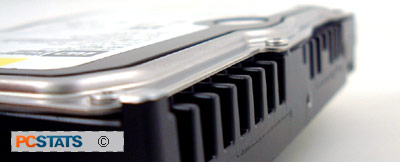Western Digital Raptor WD740 SATA Hard Drive Review
Serial ATA is finally making its full impact on the
computer landscape, and SATA drives are quickly supplanting the traditional Parallel ATA drives inside our
desktop computers. More importantly perhaps, SATA and the new SATA II
standard are finally bringing business-class hard
drive performance to non-SCSI machines.
Before SATA, there was no such thing as a non-SCSI 10,000RPM drive.... Now
with the increased speed, extra features and ease of use built into the new SATA
standards, the big hard drive manufacturers like Western Digital are porting
their enterprise-class drive technologies over. Ultimately, all users should
benefit.
In this review, PCstats is testing out a pair of
sleek 10,000 RPM Western
Digital WD740 Raptors. These are the first SATA drives we've seen that reach
10,000 RPM, and we're going to be testing them both singly and in a RAID stripe and mirror to see what kind
of performance implications we can expect to a standard PC system. The Western Digital
74GB Raptors are also going to form the basis of PCstats' updated hardware test platform, so expect
to see a lot more of these drives in our future reviews.
Let's get the specifications of these drives out of the
way first. An 8MB memory buffer handles data transfer
between the drive and the system, and Western Digital claims average read
and write times of 4.5ms and 5.9ms respectively. Average latency is 2.99ms while
the track-to-track seek time is 0.6ms. Western Digital specifies a mean
time between failures of 1.2 million hours, and the WD740 Raptor carries a
full 5 year warranty.
These
new Raptors are more or less identical to the previous line
of 37GB SATA Raptors, with the advantage of slightly faster seek times, higher
storage density, and quieter performance.
 Physically, the drives are unremarkable in appearance, but extremely heavy.
This is no doubt because WD added an extra-heavy chunk of metal to
the drive to assist in cooling. 10,000 RPM drives can produce a fierce amount
of heat, as we will see later.
Physically, the drives are unremarkable in appearance, but extremely heavy.
This is no doubt because WD added an extra-heavy chunk of metal to
the drive to assist in cooling. 10,000 RPM drives can produce a fierce amount
of heat, as we will see later.
In fact, one
side of each drive is ribbed to assist in heat dissipation.
Inside, the drive uses a pair of 37GB disk platters, with a pair of
read/write heads servicing each. 8MB of Hynix memory makes up the buffer.
SATA bridging is provided courtesy of a Marvell 88i8030C chip, and the WD740
supports Tagged Command Queuing, a feature we had not expected to see on SATA
drives. There's no support for this feature in current SATA controllers, but it
is similar to the Native Command Queuing (NCQ) technology that makes its debut
with the Serial ATA II standard. TCQ allows the drive and controller to reorder
data requests from the system based on the actual physical positioning of the
read and write heads on the platters. This should make for more efficient and
consistent data transfer.

